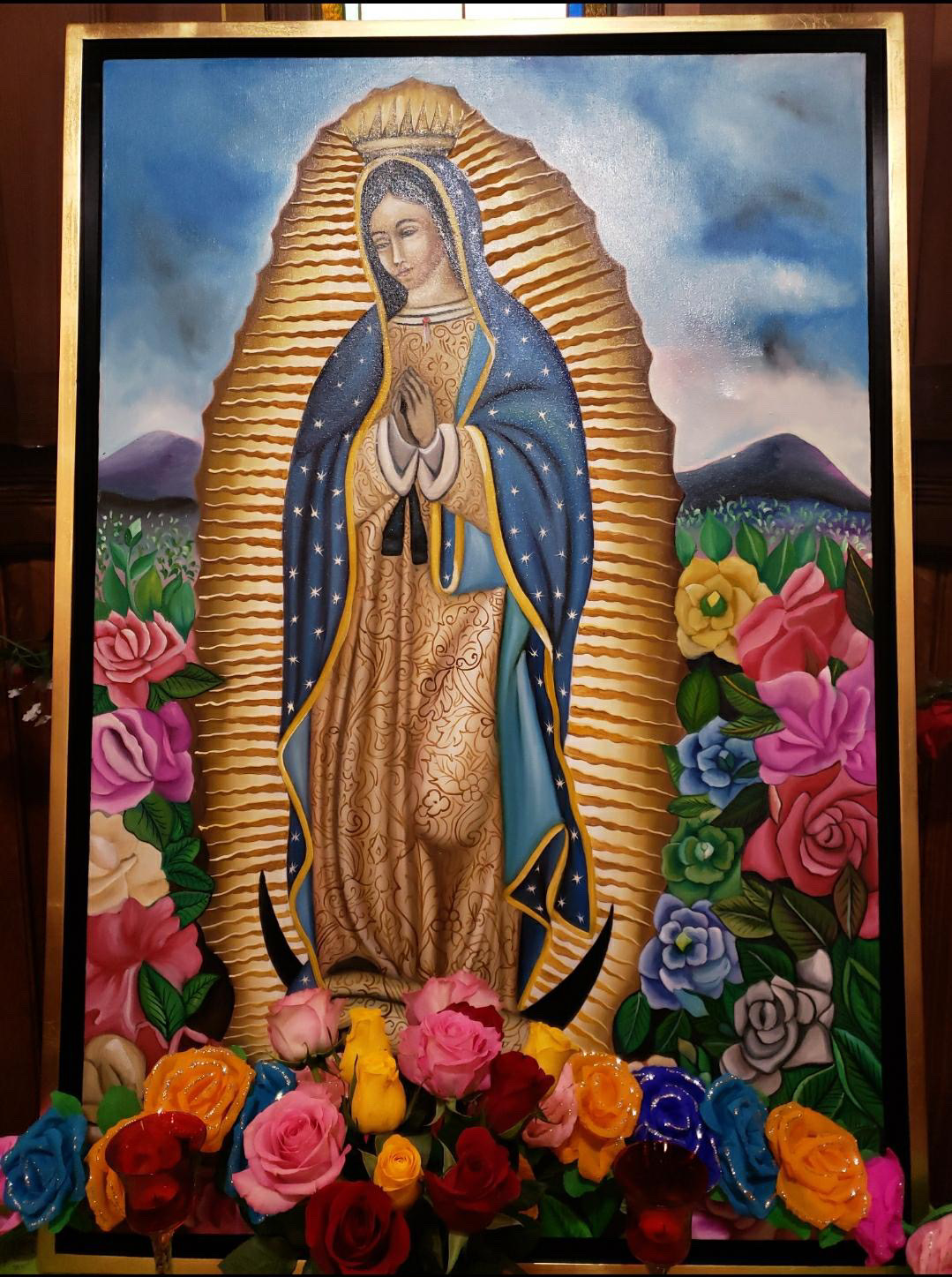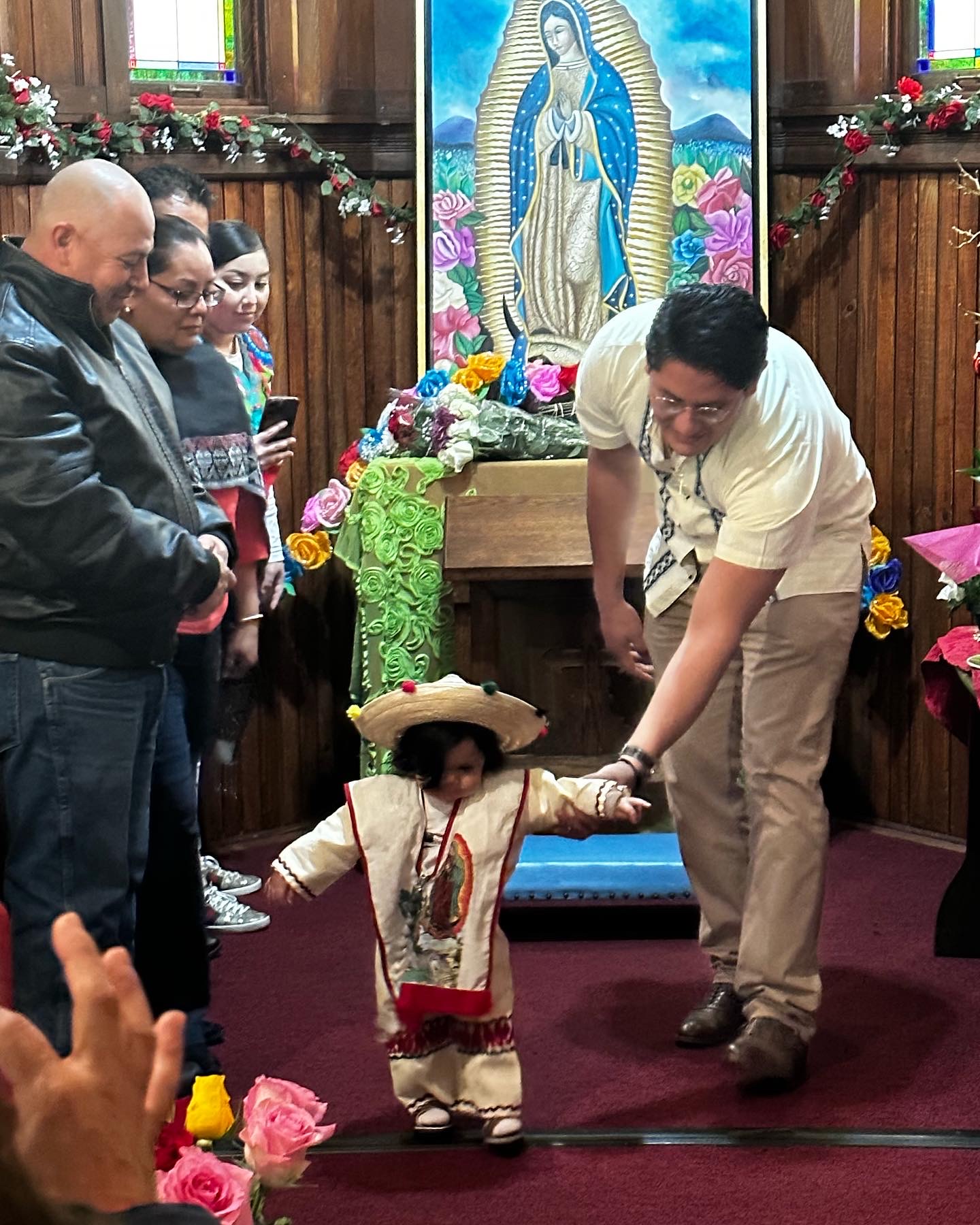Juan Diego and Our Lady of Guadalupe
Last week, many of our congregations held celebrations honoring Our Lady of Guadalupe, whose feast day is traditionally observed across the globe every December 12. The celebration of Our Lady of Guadalupe may sound familiar to many of us, particularly those of us who have grown up or lived for many years in Southern California and in proximity to Mexico and Mexican culture.
The story of Our Lady of Guadalupe takes place in 1531, a decade after the Spanish conquest of Mexico. A man originally named Cuauhtlatoatizin, later baptized as Juan Diego, was Indigenous to the Chichimeca people and a devout converted Christian. The Nican Mopohua (the earliest known recording of the story of Our Lady of Guadalupe and Juan Diego) describes him as being “poor but worthy of respect.”
One day, Juan Diego was passing by a hill in the small village of Tepeyac, when an apparition of The Virgin Mary appeared to him. She instructed Juan Diego to visit the palace of the Bishop and then ask the Bishop, Don Br. Juan de Zumarraga, to erect a chapel in Tepeyac in her honor. This chapel would be a place of comfort for all who sought her and her compassion in their troubles and pains.
Juan Diego set off to do as this apparition of Mary asked but found the task difficult. Upon arrival at the Bishop’s palace, Juan Diego begged the Bishop’s servants to allow him an audience. When Juan Diego finally met with the Bishop to tell him all he had seen and heard, Bishop de Zumarraga did not believe him.
the Bishop’s servants to allow him an audience. When Juan Diego finally met with the Bishop to tell him all he had seen and heard, Bishop de Zumarraga did not believe him.
Juan Diego returned the way he came, once again encountering the apparition of Mary, and regretfully shared with her that he had failed. The apparition encouraged Juan Diego to visit the Bishop again the next day. Juan Diego did, and again, the Bishop did not believe him. This process repeated a few times, with Juan Diego failing to convince the Bishop of the miracle of the apparition.
The Bishop, tired of Juan Diego’s harassment, threatened him with violence if he returned again.
Juan Diego pleaded with the Virgin Mary to send someone else: perhaps “one of the nobles who are held in esteem, one who is known, respected, honored…so that he will be believed.”
Juan Diego, understanding his humble status on the socioeconomic hierarchy, insisted that it was not his place to bring this vision to the Bishop. But this apparition of Mary insisted that it must be Juan Diego, and that only through his intercession could this vision of a new chapel be a reality.
To assist him, the apparition told Juan Diego to gather an abundance of cut flowers into his tilma (a type of cloak worn by the Aztecs and peoples of central Mexico), and to take these flowers to the Bishop, “that in these flowers the Bishop would see Mary’s wish.”
Juan Diego followed this command, and ventured to the Bishop’s palace for the fifth time. During this visit, as Juan Diego opened his tilma and the flowers fell to the floor, there appeared on Juan Diego’s tilma a vision of the Virgin Mary. The Bishop finally understood this sign and believed Juan Diego, and a church was then built in her honor.
 The celebration of Nuestra Senora de Guadalupe is distinctly of Mexican and Catholic origin. But the influence of “La Guadalupana” is worldwide, with countries across Latin America and elsewhere recognizing this celebration. On July 16, 1935, Pope Pius XI declared Our Lady of Guadalupe as the patron saint of the Philippines.
The celebration of Nuestra Senora de Guadalupe is distinctly of Mexican and Catholic origin. But the influence of “La Guadalupana” is worldwide, with countries across Latin America and elsewhere recognizing this celebration. On July 16, 1935, Pope Pius XI declared Our Lady of Guadalupe as the patron saint of the Philippines.
As congregations throughout EDSD prepared for her celebration this year, leaders took the time to share with me what Our Lady of Guadalupe meant to them.
For Julian Sanchez, who is of Mexican-American heritage and grew up attending St. Matthew’s in National City, where he now serves as Bishop’s Warden, the Virgin of Guadalupe symbolizes reconciliation, and a way forward.
Sanchez said, ”When I was a child, La Guadalupana meant love for the Mexican people. But now, as an adult, she means redemption to me. If I put myself in the times of Diego, a lot of acts of violence were committed to the native Mexicans by the Spanish and the Church. She appeared in a time of trouble to [move] two different cultures [toward] a new time of hope and acceptance. Though we still struggle with identity today, it was a huge first step forward [to bring us to where] we are today. As a Mexican American, Spanish, or native blood, we all stop to give thanks and gratitude for our mother of peace.”
The Rev. Brian Johnson, and the community of St. John’s, Indio, offered another perspective. Rev. Johnson said, “When the Virgin of Guadalupe appeared to Juan Diego in 1531, she became a sign of the reconciliation of the Spanish and indigenous people through a common devotion to her. Subsequently, as the “Queen of Mexico and Patron of the Americas,” she has played a unique role in national (and international) identity.
“Those who venerate the Virgin are united in spirit whenever they are, whatever their heritage. She inspires people to create communities, to give rise to social movements, and encourage social justice. Due to her wisdom and gentleness, many see her as a wise counselor and comforter, and one who will bring minor and major miracles to life. She breaks down walls of racial separation, and assures us that things which were cast down are once again being raised up.”
But what does the Virgin de Guadalupe mean to me? How does Juan Diego’s story help inform my place in the world today?
The Virgin of Guadalupe’s consistent affirmation of Juan Diego as an important and valuable leader in God’s mission resonates with me. Even as Juan Diego insists that it might be better to send another person of higher status with more social power and privilege, La Guadalupe doubles down that it must be him, in the fullness of everything that he already is.
In this, I find myself reflecting on my own past, present, and future. When have I been Juan Diego, insisting on my own lack? Who have been the people who have affirmed and uplifted me in my own journey, in the way Our Lady of Guadalupe affirmed and uplifted Juan Diego? And, who are the Juan Diegos in our midst, called to perform modern-day miracles of mission and lead us into a new, more inclusive way of being? And how can we journey alongside them, as La Guadalupana journeyed alongside Juan Diego?
As we begin our diocesan Year of Leadership, join me in reflecting on how we can be more like Juan Diego–trusting, persistent, and humble as leaders sharing the Good News of Christ with the world.
*Summarized from a translation of the Nican Mopohua
by
Category: #Advocacy, #Multicultural Ministry, #Worship & Formation
Respond to this:
One reply to “Juan Diego and Our Lady of Guadalupe”
Recent Stories
My mother was ordained an Episcopal priest on January 15, 1994, at All Saints’ Episcopal Church in Beverly Hills. I was ten years old, and her being ordained wasn’t odd […]
In December 2023, I received a letter from Julia Ayala Harris, President of the House of Deputies, saying, “I have reviewed your application and, after prayerful discernment, invite you to […]
When we love something, we share it with our friends and family; like a new show on Netflix or a great restaurant in the neighborhood, we can’t help but share […]





Delightful Rachel- thankyou for this inspiring and motivating synopsis- bless your Juan Diego opportunities!! and I will keep looking for mine☮️